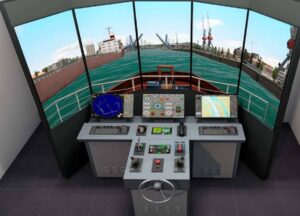
uilding on the Memorandum of Understanding (MoU) signed between Peninsula and the University of Gibraltar earlier this year, the two organizations have taken their collaboration to the next level with the creation of the Peninsula Maritime Simulation Suite, a high-tech facility, funded by Peninsula, set to support cadet education and professional development.
This investment not only fulfills mandatory UK Maritime and Coastguard Agency (MCA) training requirements but positions Gibraltar as a rising global hub for maritime excellence.
Supporting the University’s broader vision of establishing a world-class Maritime Simulation Centre, it will also help expand the reach of its BSc (Hons) Maritime Science and Cadetship program. The new suite will provide mandatory simulation training required by the UK’s Maritime and Coastguard Agency (MCA), enabling cadets to progress toward their Certificate of Competence as Officers of the Watch.
The facility will feature a Part Task Navigational Bridge Simulator, fully compliant with the MCA’s updated sea-time equivalency requirements. It will support multi-language instruction (English, Spanish, French) and offer tailored training modules for Peninsula officers and crew, including LNG bunkering scenarios and other complex operations.
Using technology from Wärtsilä, the suite will be the only facility of its kind in the region.
Aboa Mare Ups Training Capabilities with Kongsberg Maritime’s Simulator

Finland-based Aboa Mare has strengthened its maritime training capabilities by investing in a K-Sim Engine Full Mission and Desktop Simulator system from Kongsberg Maritime.
The delivery is set to be completed in the first quarter of 2026 and will include some of the most advanced simulator models available, comprising both conventional and next-generation propulsion technologies, such as hybrid, battery, dual-fuel, LNG and methanol-fuelled engines.
With the new simulator, Aboa Mare’s students and professional seafarers will receive practical training that aligns with the global maritime industry’s green transition.
The K-Sim Engine simulator system is fully compliant with STCW requirements and DNV standard ST-0033 and will be delivered with DNV Class A & C certification, ensuring the highest levels of quality and realism in maritime training. The simulator will be the first at Aboa Mare with DNV classification.
“We are committed to delivering high-quality training that reflects the latest developments in maritime operations. The collaboration with Kongsberg enables us to provide realistic and future-oriented learning environments.
“By integrating the latest propulsion technologies into our training, we are ensuring that our students and customers are well prepared to contribute to the industry’s green transition,” said Thomas Lundberg, Simulator Manager, Aboa Mare.
Wilson Sons Launches New Tug Simulator Training Center in Brazil
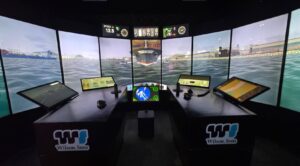
Shipping and logistics firm Wilson Sons has opened new facilities at its Training Centre and Towage Operations Centre in Santos, São Paulo, including a tugboat manoeuvre simulator designed to improve operating safety, efficiency and sustainability.
This simulator will train the company’s captains and maritime workers on safety procedures and cutting-edge technology for its fleet of over 80 tugboats, which operate in more than 25 ports along the Brazilian coast, supporting domestic and international trade, as well as the offshore energy industry.
Simulator training enhances operating safety and efficiency, and supports the analysis and improvement of manoeuvres of large ships (up to 366 meters), which reduces operating restrictions at Brazilian ports.
Another special feature of this technology is scenario analysis, where different environments are simulated, and solutions are tested and developed for different port challenges faced in Brazil, with customized simulations for each port.
“The technology behind the new manoeuvre simulator supports our innovation strategy. It is a tool that increases the safety and efficiency of our operations, supporting the growth of the Brazilian port industry and the competitiveness of the global logistics chain,” said Rodrigo Bastos, Director of Towage Operations at Wilson Sons.
The manoeuvre simulator can also be used by clients and other stakeholders in project analysis and testing activities. Wilson Sons’ Towage Operations Centre (COR) had been set in the same location, and in 2011, it began real-time monitoring of the company’s tugboat fleet.
Seamen’s Church Institute and KOTUG to Strength Maritime Training
The Seamen’s Church Institute (SCI) and KOTUG Training & Consultancy (KTC) have renewed their strategic partnership to expand world-class maritime training opportunities for U.S. mariners.
SCI, through its Center for Maritime Education, is a leading provider of simulation-based training in the United States. With this renewed partnership, SCI will leverage KOTUG’s internationally recognized trainers and consultants to enhance its harbor tug training programs and integrated tug master–ship pilot courses. KOTUG, a global leader in harbor, river, and terminal towage training, will benefit from access to SCI’s state-of-the-art vessel and tug simulators. Together, the organizations will offer complementary services to ports, terminals, and the inland tug and barge industry, ensuring mariners have access to advanced training and innovative assessment tools.
“The renewal of our partnership with KOTUG reflects our shared commitment to maritime safety and excellence,” said The Rev. Mark Nestlehutt, President and Executive Director, The Seamen’s Church Institute. “By combining our facilities with KOTUG’s global expertise, we can deliver the highest quality training for American mariners.”
“We are proud to continue working with SCI,” said Ard-Jan Kooren, CEO, KOTUG. “This collaboration merges international best practices with SCI’s deep knowledge of the U.S. market, providing unparalleled opportunities for maritime professionals.”
The renewed agreement strengthens both organizations’ ability to meet the evolving demands of the maritime industry and supports their mission to enhance safety, performance, and professionalism on the water.
Kongsberg Maritime Invests Quarter of a Million in Advanced Simulator
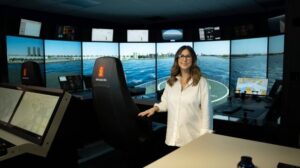
Kongsberg Maritime, a leading technology partner for the maritime industry announces the launch of its cutting-edge K-Sim Offshore DP3 Anchor Handling Simulator, setting a new standard for training and operational excellence in the Maritime sector.
With an investment of over £250,000, this innovative training solution is designed to elevate competency standards, enhance operational efficiency, and promote sustainability across the sector. Additionally, it focuses on improving maritime safety by supporting our local customers and partners in ensuring safe operations and reducing risks in critical maritime activities.
Situated at Kongsberg Maritime’s Aberdeen office in Westhill, the simulator has been upgraded in response to the growing need for skilled Dynamic Positioning professionals, particularly in offshore oil and gas operations, including drilling, pipe-laying, heavy lift and emerging floating wind operations . The simulator will provide operators with the essential skills and expertise needed to safely and efficiently support large-scale projects in the North Sea and across Europe.
The simulator provides a highly realistic training environment, allowing course delegates to practice complex operations and emergency preparedness in a fully immersive, controlled conditions. By replicating real-world scenarios with advanced physics-based simulations, it improves competency, enhances safety, and reduces reliance on expensive on-the-job training.
To further support the simulator, Kongsberg is increasing its instructor team from two to three expert Dynamic Positioning Operators in 2025, bringing a wider range of knowledge and experience to strengthen its training programs.
Kerry Craig, Operations Manager at Kongsberg Maritime, said, “In today’s maritime industry, we face increasing operational complexity, heightened safety demands, and the urgent need to reduce environmental impact, all while managing tighter budgets and a growing skills gap. Kongsberg Maritime set out to develop a solution that would provide highly realistic, risk-free training whilst ensuring operators gain the skills and confidence needed to perform at the highest level.”
“The K-Sim Offshore DP3 Anchor Handling Simulator sets itself apart with advanced physics-based simulations and hydrodynamic modelling, allowing trainees to operate in a variety of vessel types, locations, and weather conditions. This level of realism enhances competency among operators, leading to better performance in the field. This is about empowering people with the right tools to work smarter, safer, and more sustainably, driving a real ‘step change’ in maritime training,” said Kerry.
Kongsberg Maritime also aims to collaborate with local ports and universities to maximise the potential of the new simulator’s functionality. While the simulator is designed for onsite training, these partnerships are expected to enrich the training programs and contribute to the development of future maritime professionals.
PSA Marine to expand simulator training capabilities for pilots
PSA Marine in Singapore has entered into a strategic collaboration with Kongsberg Digital to improve maritime harbour pilot training through the use of simulation technology, including the development of skills in managing autonomous ships and sustainable propulsion systems.
PSA Marine provides pilotage service to more than 180,000 vessels annually in the Port of Singapore, ranked as the world’s busiest container transhipment hub, and will expand its training infrastructure with the installation of new simulators from Kongsberg Digital in April 2025.
The package will include a Full Mission Bridge Simulator and a Full Mission Tug Bridge Simulator (Both Class A), including environments tailored to Singapore’s unique maritime conditions, enabling users to practice scenarios such as navigating dense traffic, managing new vessel types, and responding to emergencies.
“The collaboration underscores our commitment to innovation and excellence, empowering our people with the advanced technologies and skills to thrive in a rapidly evolving landscape,” said Er Wei Lim, Managing Director at PSA Marine.
“We look forward to future collaborations to co-create innovative maritime solutions together.”
Simulators Track our Changing Relationship with Technology
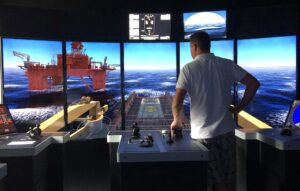
We have a close relationship with technology, evidenced by, for example, the phones we are estimated to unlock around 50-80 times a day. It has changed us. Half the people surveyed in a 2022 King’s College London study said that they feel like their attention span is shorter than it used to be. They are wrong, though, if they think that the average attention span of adults today is just eight seconds, one second less than goldfish. The science behind these attention span perceptions is limited, but educators do still now have an “attention economy” to consider.
MarinePALS founder Captain Pradeep Chawla says that people are used to accessing information in a variety of short and entertaining ways. MarinePALS is therefore embracing a new approach that involves interactive experiences and bitesize training materials, including micro-learning videos, gaming apps, VR programs and online mentoring.
“These digital methods are more effective than traditional learning methods, because they mimic the way people live today,” says Chawla. The gamification of learning makes it fun, he says.
There are practical benefits. Virtual reality headsets with the right training package can instruct seafarers how to use specific equipment in a realistic environment, which in turn can reduce the time they need to spend on a simulator. This saves time and money and frees up simulator time for others.
Once onboard the simulator, seafarers can expect a comprehensive experience. Wärtsilä will supply its latest technology for a new maritime training center in Finland that will have two engine room simulators along with two large and three medium sized full mission navigational bridges with 360-degree visualization. They will include digital chart tables and a separate bridge wing console operated in virtual reality.
Japanese simulator centre opens for offshore training
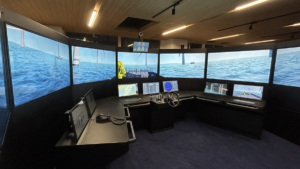
Nippon Yusen Kaisha (NYK) has opened a training centre with simulators in Akita, Japan to train crew for offshore windfarm projects
The Offshore Wind Training Centre has facilities for teaching technical personnel and workboat crews essential skills for manoeuvring vessels, engineers and supplies to wind turbines and foundations in offshore windfarms.NYK expects this to be a focal point for specialised training in offshore wind installations at a time when Japan is implementing its first renewable energy projects.
Its main facility is a full-mission bridge simulator tailored for offshore wind operations, supplied by Damen Services and VStep Simulation.
“This simulator provides the means for fleet owners in the Asia-Pacific region with the opportunity to safely test and train their crews in various ship designs, including the Damen fast crew supplier FCS 2710,” said Damen regional service manager for Asia-Pacific, Bastin Kubbe.
This full-mission bridge simulator completed factory acceptance testing in October and was then installed at the Japanese training centre.
“This simulator is designed to replicate real-world scenarios, its advanced capabilities offer a comprehensive training experience,” said NYK energy division’s executive officer and senior general manager Tsutomu Yokoyama.
“Its integration into the training centre underscores NYK-Line’s commitment to excellence in the offshore wind sector.”
The centre in Akita will be officially inaugurated on 1 April. It was built with NYK in a consortium with Damen Services that goes beyond providing these training facilities.
Both companies engage in collaborative initiatives with local governmental bodies and educational institutions to actively contribute to offshore human resource development.
“The strategic focus of this project is on expanding the offshore wind industry,” said Damen regional sales director for Asia Pacific, Thomas Röwekamp. “It also looks to ensure a skilled workforce.”
AR Simulator Added to Pilot Training at Smartship Australia

Force Technology won a deal to deliver its SimFlex4 AR solution as part of an extensive upgrade for the Queensland-based maritime simulation and training facility, Smartship Australia, which focuses on professional pilotage training and development. Smartship’s facility in Brisbane includes five marine simulators, including two full mission bridges, one Tug bridge, and two-part task simulators.
FORCE Technology’s SimFlex simulator was originally selected when Smartship Australia was first established in 2011. Since then, the facility has supported every significant port development project in Queensland. Smartship Australia also delivers services to other states in Australia as well as international customers in New Zealand, Papua New Guinea, Indonesia, and Thailand.
The simulation center upgrade commenced in October 2023 and will result in the installation and commissioning of an augmented-reality (AR) simulator in the first quarter of 2024. The simulator platform is ready for FORCE Technology’s upcoming DEN-Mark2 mathematical model release in 2024, which will offer unprecedented model accuracy as well as enhanced line forces calculations, a major advantage when operating with tugboats and conducting advanced mooring studies, for example. In use for more than 35 years, the DEN-Mark1 mathematical model is renowned for its accuracy, but DEN-Mark2 will introduce a major technology leap in fidelity and physical capabilities.
Wärtsilä to supply simulator to NSB Group
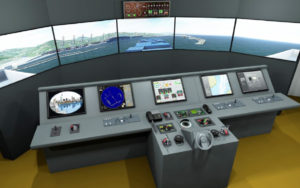
Technology group Wärtsilä will supply its simulator to global maritime service company NSB Group.
The simulator will be installed in NSB’s Maritime Training Centre in Buxtehude, Germany as part of a technical upgrade for the centre. The order was booked by Wärtsilä in February 2023.The simulator will feature the latest versions of Wärtsilä’s Navi-Trainer professional simulation software, as well as the latest NACOS Platinum bridge systems which include multi-pilot workstations for Electronic Chart Display and Information System (ECDIS), radar and conning applications.
The simulator is combined with a visualisation system, an Interactive Bridge Information Display (IBID) technology, a 55-inch (1.4-metre) voyage planning table connected to the main bridge, a video and audio recording and playback system, as well as a new sound system.
Tim Ponath, NSB’s CEO, said: “This upgrade will help us practice ‘what-if’ scenarios to meet our high standards in shipping and our ability to respond and improve in a very personalised way to meet the needs of our customers. Wärtsilä’s simulator makes it possible to connect different training centres in a way that has never been done before. After the first opening in 2007, we now again have a sophisticated stand-alone training facility.”
Johan Ekvall, Head of Product Simulation & Training at Wärtsilä, commented: “The skills shortage is a real issue facing the maritime industry today. Since COVID-19, many have left the industry and new recruits are not coming in fast enough to replace them. It’s clear we need to be able to get mariners up to speed quickly and ensure they undergo robust training to maintain high standards. NSB Group does great work in bridging this gap and delivering enriching training programmes to students across shipping.”
Evgeny Vdovin, Director of Port Optimisation and Simulation at Wärtsilä added: “It’s exactly for this reason that we, at Wärtsilä, are pleased to support NSB Group with their commitment to safety, training and education by providing the vital technology that is helping to shape the crews of tomorrow.”
The new simulator complies with DNV Standard 0029 for maritime training centres. It will be used for the further training of officers, for briefings and familiarisation, and to prepare seafarers for promotions. The courses are designed to accommodate both NSB personnel and external trainees.